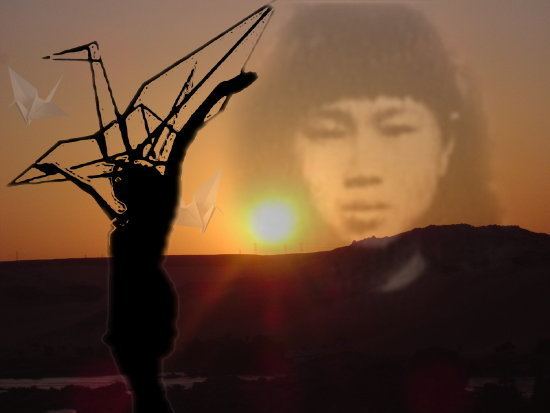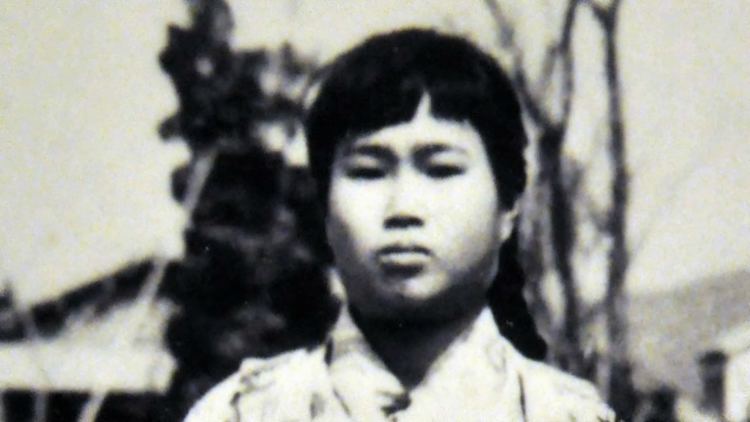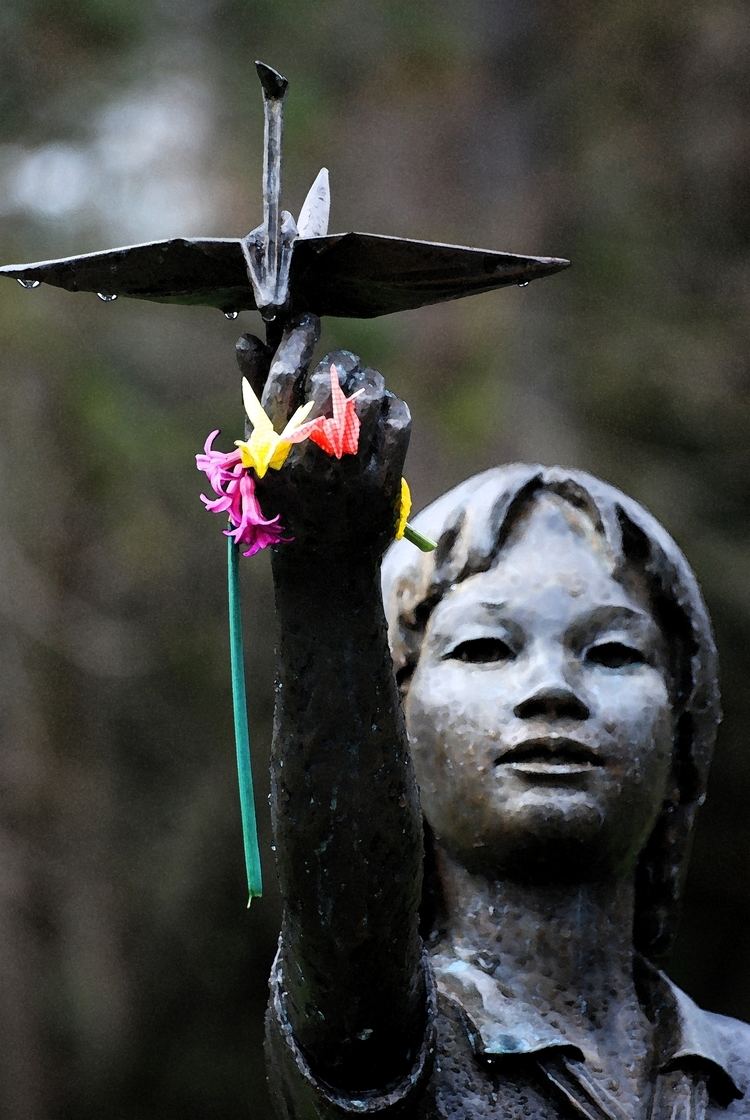Full Name Sadako Sasaki Website [1] Cause of death Leukemia Name Sadako Sasaki | Nephews Yuji Sasaki Occupation Student | |
 | ||
Education Nobori-cho Elementary School Siblings Mitsue Sasaki, Eiji Sasaki, Masahiro Sasaki Parents Shigeo Sasaki, Fujiko Sasaki Grandparents Daisaku Sasaki, Matsu Sasaki, Ichiyo Yamamoto, Hisatarou Yamamoto | ||
Remembering sadako sasaki
Sadako Sasaki (佐々木 禎子, Sasaki Sadako, January 7, 1943 – October 25, 1955) was a Japanese girl who was two years old when an American atomic bomb was dropped on Hiroshima on August 6, 1945, near her home next to the Misasa Bridge. Sadako became one of the most widely known hibakusha — a Japanese term meaning "bomb-affected person". She is remembered through the story of the one thousand origami cranes she folded before her death, and is to this day a symbol of the innocent victims of nuclear warfare.
Contents

2000 paper cranes a memorial to sadako sasaki
Overview

Sadako was at home when the explosion occurred, about 2 kilometres (1.2 mi) away from ground zero. She was blown out of the window and her mother ran out to find her, suspecting she may be dead, but instead finding her two-year-old daughter alive with no apparent injuries. While they were fleeing, Sadako and her mother were caught in the black rain. Her grandmother rushed back to the house and was never to be seen again. Subsequently, Sadako grew up like any other girl, becoming an important member of her class relay team.

In November 1954, Sadako developed swellings on her neck and behind her ears. In January 1955, purpura had formed on her legs. Subsequently, she was diagnosed with acute malignant lymph gland leukemia (her mother referred to it as "an atom bomb disease"). She was hospitalized on February 20, 1955, and given, at the most, a year to live.

Several years after the atomic explosion, an increase in leukemia was observed especially among children. By the early 1950s, it was clear that the leukemia was caused by radiation exposure.
She was admitted as a patient to the Hiroshima Red Cross Hospital for treatment and blood transfusions on February 21, 1955. By the time she was admitted, her white blood cell count was six times higher compared with the levels of an average child.
In August 1955, after two days of treatment, she was moved into a room with a roommate, a junior high school student who was two years older than her. It was this roommate who told Sadako about the Japanese legend which promises that anyone who folds one thousand origami cranes will be granted a wish, and taught her how to fold the origami cranes. Although she had plenty of free time during her days in the hospital, Sadako lacked paper. She would use medicine wrappings and whatever else she could scrounge; this included going to other patients' rooms to ask to use the paper from their get-well presents. Also, her best friend, Chizuko Hamamoto, would bring paper from school for Sadako to use.
A popular version of the story is that Sadako fell short of her goal of folding 1,000 cranes, having folded only 644 before her death, and that her friends completed the 1,000 and buried them all with her. (This comes from the book Sadako and the Thousand Paper Cranes.) However, an exhibit which appeared in the Hiroshima Peace Memorial Museum stated that by the end of August 1955, Sadako had achieved her goal and continued to fold more cranes. Also, in a black-and-white documentary film her father said that she had made 644 paper cranes, which his parents had kept (he showed them in the documentary), and that her classmates made an additional 1,000 paper cranes, which were buried with her.
During her time in the hospital her condition progressively worsened. Around mid-October her left leg became swollen and turned purple. After her family urged her to eat something, Sadako requested tea on rice and remarked "It's tasty". Those were her last words. With her family around her, Sadako died on the morning of October 25, 1955 at the age of 12.
After her death, Sadako's body was examined by the Atomic Bomb Casualty Commission (ABCC) for researching the effects of the atomic bomb on the human body. It was later revealed that the ABCC had also conducted tests on Sadako while she was alive for the same reasons.
Memorial
After her death, Sadako's friends and schoolmates published a collection of letters in order to raise funds to build a memorial to her and all of the children who had died from the effects of the atomic bomb, for example the Japanese girl Yoko Moriwaki. In 1958, a statue of Sadako holding a golden crane was unveiled in the Hiroshima Peace Memorial Park. At the foot of the statue is a plaque that reads: "This is our cry. This is our prayer. Peace in the world."
There is also a statue of her in the Seattle Peace Park. Sadako has become a leading symbol of the impact of nuclear war. Sadako is also a heroine for many girls in Japan. Her story is told in some Japanese schools on the anniversary of the Hiroshima bombing. Dedicated to Sadako, people all over Japan celebrate August 6 as the annual peace day.
